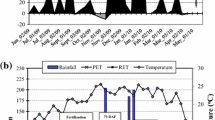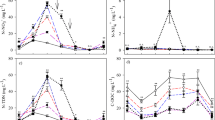Abstract
Cropping systems and fertilizer management strategies that effectively use applied nitrogen (N) are important in reducing costs of N inputs. We examined the effect of time of N application on dry matter (DM) and grain yield (GY), N accumulation, the N budget in crop from soil, fertilizer and atmosphere, and the fertilizer N use efficiency (estimated by the conventional difference method, and the direct 15N recovery by the crops), in a sorghum/pigeonpea intercropping system on an Alfisol (Ferric Luvisols (FAO); or Udic Rhodustalf (USDA) in India. Fertilizer N was applied at planting (basal) and at 40 days after sowing (delayed). Nitrogen was applied only to the sorghum rows in the intercropping treatment. Nitrogen derived from air (Ndfa) was estimated by the15 N natural abundance method, and N derived from fertilizer (Ndff) was estimated by the 15N isotope dilution method.
Delaying N fertilization till 40 days after sowing (DAS), rather than applying at sowing increased DM and GY of the sorghum, but not of pigeonpea. Delaying N fertilization to sorghum for 40 days significantly (p<0.001) increased 15N recovery in shoot from 15 to 32% in sole crop, and from 10 to 32% in intercrop. Similarly, there was a significant (p<0.001) increase in N recovery (by the difference method) from 43 to 59% in sole crop and from 28 to 71 % in intercrop sorghum. Fertilizer N recovery by sole crop pigeonpea (14%) was higher than intercrop pigeonpea (2–4%). Pigeonpea fixed between 120–170 kg ha-1 of atmospheric N throughout the cropping season. Although there was a marked difference in nitrate-N (N03-N) concentrations between basal and delayed treatments at planting, no difference was observed in N03-N concentrations in soil solution between the treatments at 40 DAS. Our data on N accumulation by plants showed that the rate of N depletion or disappearance from the soil solution was 2–3 times faster than N accumulation by plants, suggesting that an appreciable amount of N03-N would disappear from soil solution in the top soil without being utilized by crops during the initial growth stage.
Similar content being viewed by others
References
Adu-Gyamfi JJ, Katayama K, Gayatri Devi, Rao TP & Ito O (1996) Improvement of soil and fertilizer nitrogen use efficiency in intercropping. In: Ito O, Johansen C, Adu-Gyamf JJ Katayama K, Kumar Rao JVDK & Rego TJ (eds) Dynamics of Roots and Nitrogen in Cropping System of the Semi-arid Tropics, pp 493–506. Japan International Research Center for Agricultural Sciences (JIRCAS), JIRCAS International Agriculture series No 3, Tsukuba
Ali M (1990) Pigeonpea: Cropping systems. In: Nene YL, Hall SD & Sheila VK (eds) The Pigeonpea, pp 279–301, ISBN 0-85198-675-9 CABI
Cataldo DA, Haroon M, Schrader LE & Youngs VL (1975) Rapid colorimetric determination of nitrate in plant tissue by nitration of salicyclic acid. Commun Soil Sci Plant Anal 6: 71–80
Chaykin S (1969) Assay of nicotinamide deaminase. Determination of ammonium by the indophenol reaction. Anal Biochem 32: 375–382
Dalal RC (1974) Effect of intercropping maize with pigeonpea on the grain yield and nutrient uptake. Exp Agric 10: 219–224
De Datta SK, Buresh RJ, Obcemea WN & Castillo EG (1990) Nitrogen-15 balances and nitrogen fertilizer use efficiency in upland rice. Fert Res 26: 179–187
Evans J, Fettell NA & O'Connor GE (1996) Nitrate accumulation under pea cropping and the effects of crop establishment methods: a sustainability issue. Aust J Exp Agric 36: 581–586
Gadhia DS, Khanpara VD & Patel JC (1993) Production potential and economic returns of pearlmillet (Pennisetum glaucum)-based intercropping system with different grain legumes and oilseed crop under rainfed condition. Ind J Agron 38(2): 282–283
Gomez KA & Gomez AA (1984) Statistical procedures for agricultural research. 2nd ed. John Willey & Sons, New York
Guillard K, Griffin, GF, Allinson DW, Rafey MM, Yamartino WR & Pietrzyky SW (1995) Nitrogen utilization of selected cropping systems in the US Northeast: I. Dry matter yield, N uptake, apparent N recovery, and N use efficiency. Agron J 87: 193–199
Gupta ML & Sharma OL (1984) Studies on sorghum/pigeonpea intercropping under rainfed conditions: Ind J Agron 29: 213–217
Hansen EA & Harris AR (1975) Validity of soil-water samples collected with porous ceramic cups. Soil Sci Soc Am Proc 39: 528–536
Hiebsch CK & McCollum RE (1978) Area-time equivalency ratio: A method for evaluating the productivity of intercrops. Agron J 79: 15–22
Jansson S L & Persson J (1982) Mineralization and immobilization of soil nitrogen. In: Stevension J (ed) Nitrogen in Agricultural Soils pp 229–252. Agronomy series No. 22. ASA, CSSA, SSSA, Madison, WI
Jenkinson DS, Fox RH & Rayner H (1985) Interactions between fertilizer nitrogen — and soil nitrogen the so-called “priming” effect. J Soil Sci 36: 425–444
Katayama K, Ito O, Matsunaga R, Adu-Gyamfi JJ, Rao TP, Anders MM & Lee KK (1995) Nitrogen balance and root behavior in four pigeonpea-based intercropping. Fert Res 42: 315–319
Kumar Rao JVDK, Thompson JA, Sastry PVSS, Giller KE & Day JM (1987) Measurement of N2 fixation in field-grown pigeonpeas [Cajanus cajan (L) Millsp] using 15N-labelled fertilizer. Plant Soil 101: 107–113
Kumar Rao JVDK, Johansen C & Usha Kiran M (1995) Nitrogen requirements at different growth stages of short-duration pigeonpea (Cajanus cajan L Millsp.). J Agron Crop Sci 175: 15–28
Litaor MI (1988) Review of soil solution samplers. Water Resour Res 24: 727–733
Magjid J & Christiansen N (1993) Soil solution sampled with and without tension in arable and heathland soils. Soil Sci Soc Am J 57: 1463–1469
Mead R & Willey RW (1980) The concept of a ‘Land equivalent Ratio’ and advantages in yields from intercropping. Exp Agric 16: 217–228
Moraghan JT, Rego TJ & Buresh RJ (1984) Labelled nitrogen fertilizer research with urea in the semi-arid tropics. III. Field studies on Alfisols. Plant Soil 80: 193–203
Morris CF & Paulsen GM (1985) Development of hard winter wheat after anthesis as affected by nitrogen nutrition. Crop Sci 25: 1007–1010
Naraian P, Verma B & Singhal AK (1980) Nitrogen economics through intercropping of pigeonpea and rainfed sorghum. Ind J Agron 25: 190–196
Senaratne & Hardarson G (1988) Estimation of residual N effect of faba bean and pea on two succeeding cereals using 15N methodology. Plant Soil 110: 81–89
Shaffer KA, Fritton DD & Baker DE (1979) Drainage water sampling in a wet dual-pore system. J Environ Qual 8: 241–246
Shearer G & Kohl DH (1986) N2 fixation in field settings: Estimations based on natural 15N abundance. Aust J Plant Physiol 13: 699–756
Soundarajan D (1978) Studies on intercropping in red gram under rainfed conditions. MSc thesis, Tamil Nadu Agricultural University, Coimbatoire
Srinivasan A & Ahalwat IPS (1984) Studies on plant pattern and phosphate fertilization of sole and mixed stands of pigeonpea. Ind J Agron 29: 249–253
Strong WM (1995) Nitrogen fertilization of upland crops. In: Bacon PE (ed) Nitrogen Fertilization in the Environment. pp 129–169. Marcel Dekker, Inc., Hong Kong
Tobita S, Ito O, Matsunaga R, Rao TP, Rego TJ, Johansen C & Yoneyama T (1994) Field evaluation of nitrogen fixation and use of nitrogen fertilizer by sorghum/pigeonpea intercropping on an Alfisol in the Indian semi-arid tropics. Biol Fertil Soils 17: 241–248
Van der Ploeg RR and Beese F (1977) Model calculation for the extraction of soil water by ceramic cups and plates. Soil Sci Soc Am J 41: 466–470
Venkateswarlu J, Sanghi NK, Rao UMB & Rao CH (1981) Maximum production in sorghum/pigeonpea intercropping system in the semi-arid tropics. In: Nene YL & Kumble V (eds) Proceedings of the International Workshop on Pigeonpeas, Volume 1, pp 30–34. ICRISAT, Patancheru
Venkateswarlu S & Subramanian VB (1990) Productivity of some rainfed crops in sole and intercrops systems. Ind J Agric Sci 60(2): 106–109
Author information
Authors and Affiliations
Rights and permissions
About this article
Cite this article
Adu-Gyamfi, J.J., Ito, O., Yoneyama, T. et al. Timing of N fertilization on N2 fixation, N recovery and soil profile nitrate dynamics on sorghum/pigeonpea intercrops on Alfisols on the semi-arid tropics. Nutrient Cycling in Agroecosystems 48, 197–208 (1997). https://doi.org/10.1023/A:1009788818738
Issue Date:
DOI: https://doi.org/10.1023/A:1009788818738




